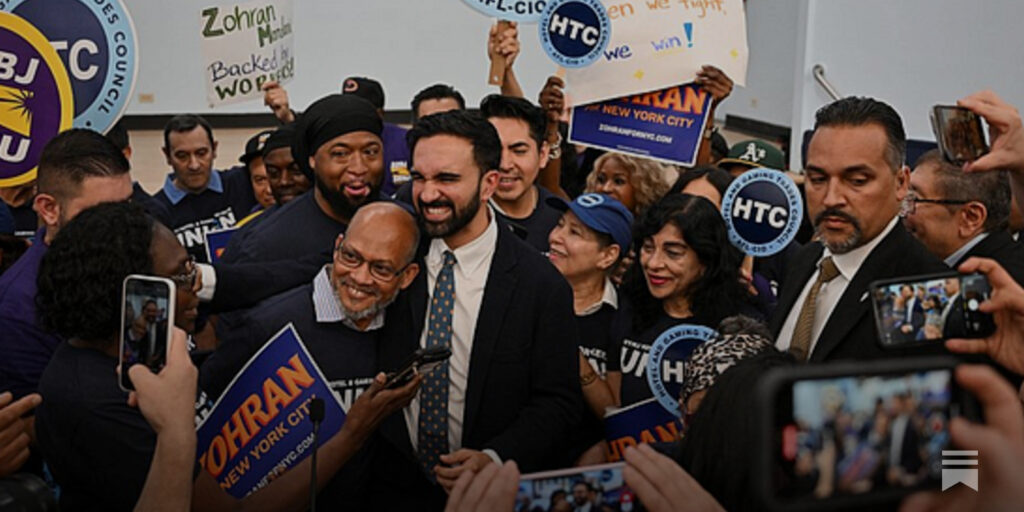After nearly six months of President Trump in the White House, California Governor Gavin Newsom visited a coffee shop in this small South Carolina city to deliver a message of resistance.
Democrats here felt a sense of spiritual and political revival. After enduring the pain and trauma of the 2024 election, they believed they were in the presence of an uplifting leader with the expertise to revitalize the Democratic grassroots.
Marion Wagner, a retired postal worker, expressed her depression as she waited for Newsom at his first stop at LilJazZi’s cafe on Tuesday. She found solace in the belief that this visit was a ray of hope.
connect with rural Deep South communities.

Suzanne La Rochelle, the executive director of the Florence County Democratic Party, expressed gratitude to the tall, svelte 57-year-old West Coast politician after he delivered his political sermon. She said, “Thank you for suing Trump!”
Joyce Black, a 63-year-old grant writer, pumped her fist and exclaimed, “This is just the jolt that South Carolina needs!”
Newsom, who had traveled over 2,000 miles from California to South Carolina, promoted his journey as a means to aid the party in regaining control of the U.S. House of Representatives in 2026. He aimed to connect directly with rural communities in the Deep South that had been neglected by Republicans.
The governor, considering a 2028 White House bid
However, the majority of the public believed that the governor, who is considering a White House bid in 2028, was in the Palmetto State to establish connections in a pivotal election state that historically hosts the South’s inaugural presidential primary. Currently, California has twelve competitive House districts, but none are located in South Carolina.
In Camden, South Carolina, the state’s Representative James Clyburn, the most prominent Black member of Congress and a well-known Democratic strategist who helped former President Biden win in 2020, addressed the elephant in the room when he joined Governor Gavin Newsom.
“As we welcome these presidential candidates, let’s not forget about the importance of school boards,” Clyburn said.
Newsom looked a bit awkward and the crowd laughed. Jokingly, Newsom turned around as if looking for another, unidentified politician behind him.
Newsom, a former San Francisco mayor elected governor in 2018, faces challenges if he runs for president.
Being a Californian is seen as a liability.
Despite its fourth-largest economy and high-tech prowess, income inequality and rising costs of living make Republicans portray California as a state of elite “woke” activism and high taxes, homelessness, and crime.
Republican activists at Newsom’s “Meet and Greet” in Pickens, a staunchly red county that voted 76% for Trump, emphasized the GOP narrative:
“Your state is a mess, and you want to run this country? No way!”
“Keep your socialist junk in California!”
Tamra Misseijer, a Pickens County middle school teacher, moved from Woodland Hills to South Carolina in 2021 due to affordability issues and the impact of homeless people on her yard. She also criticized Newsom’s COVID-19 pandemic restrictions.
“We traded unconstitutional lockdowns and masks for freedom and fresh air,” read the placard of a registered Republican. “High crime, looting, and destruction for peace and order.”
Even some Democrats express concern that Newsom’s progressive views, wealth, and slick demeanor may hinder their ability to win over working-class and swing voters in Republican and closely divided states.
Richard Harpootlian, a former South Carolina senator and Democratic Party chairman, predicted Newsom’s challenges in gaining traction in the state.
Harpootlian acknowledged Newsom’s attractiveness but noted the party’s search for a left-of-moderate candidate who can articulate blue-collar aspirations. He doubted Newsom’s ability to appeal to blue-collar voters.
Harpootlian dismissed Newsom as a wealthy man who benefited from his connections with the Getty oil fortune and dismissed his understanding of winning back blue-collar voters. He suggested that Newsom’s track record of addressing significant issues like homelessness and the social safety net would make him more palatable, but he believes he will face difficulties explaining California’s numerous failures.
Newsom’s tour energized South Carolina Democrats and raised money.
SCDP Chair Christale Spain invited several prominent national Democratic leaders to tour the state, but only Newsom immediately agreed to join her on a plane.
After exchanging emails and text messages, a Newsom advisor revealed that Newsom had raised $160,000 for South Carolina’s Democratic Party, which is nearly two-thirds of what the Democratic National Committee allocates to the party’s annual budget.
Newsom, who traveled to Georgia in 2023 for a highly anticipated debate with Florida Governor Ron DeSantis and to South Carolina in 2024 to campaign for President Biden, expressed his belief that national Democratic leaders have neglected the rural South.
At a packed gathering at Fisher Hill Community Baptist Church in Chesterfield, Newsom expressed his dissatisfaction with his party, stating that they had failed to support the South for decades.
Newsom avoided the question of whether he would run for president, arguing that Democrats could not afford to wait for a savior for 3.5 years.
He emphasized that one of the significant mistakes for any party, particularly the Democratic Party, is to seek a single individual to rescue them.
Newsom offered a glimpse of a potential presidential campaign: he touted his record of suing Trump, celebrated California as un-Trump, and criticized Trump’s immigration raids.
“America is reversing,” Newsom said in Camden. “They’re trying to return us to a pre-1960s world on voting rights. Civil rights, LGBTQ rights, women’s rights, and access to abortion and contraception are at stake. It’s a moment we didn’t expect.”
Despite warning about book bans and immigration raids as attacks on democracy, Newsom resisted the notion of America being neatly divided by east and west, rural and urban, Democrat and Republican.
“California is a large red state,” he said, noting he represented over 6 million Trump voters, more than South Carolina’s entire population.
He admitted to giving up self-medication after the election, finding it a body blow.
Within a short span of time, Governor Newsom swiftly re-engaged in the political arena. On November 7th, two days following the election, he convened a special session of the state Legislature with the explicit purpose of safeguarding California’s cherished values and fundamental rights against the incoming administration of President Trump.
Newsom emphasized that Democrats across the nation, from California to South Carolina, shared a collective responsibility to take decisive action.
“We are not mere spectators in this global unfolding,” he asserted. “We possess the capacity to shape the future and wield our agency. While you could have remained complacent, succumbed to resignation, or succumbed to cynicism, negativity, and anxiety, as I am certain many of you are experiencing in this critical juncture, we have chosen to stand firm.”
The audience was visibly captivated by Newsom’s presence. Some were moved to tears by his exquisite locks and charismatic demeanor. Others were astounded by his ability to confront President Trump with both clarity and compassion.
One woman expressed her heartfelt admiration for Newsom, conveying that her friend harbored romantic feelings for him. Another shared a personal anecdote, recounting that she experienced a moment of profound stupefaction upon meeting him, rendering her speechless.
“He’s a cool dude,” Carol Abraham, wife of the mayor of Bennettsville, said after Newsom spoke at a meet and greet. “He has swag.”
Bryanna Velazquez, a 31-year-old business owner, waited in a long line to thank Newsom for speaking out against immigration raids.
“I’m married to a Mexican citizen, so it means a lot,” she said. “But I’m still afraid because he’s brown.”
broadens national appeal by defying left-wing orthodoxies.
Since Trump’s 2024 electoral victory, Newsom has emerged as the most vocal Democratic critic of the president. He has taken steps to defy left-wing orthodoxy and expand his national appeal in a country that politically diverges significantly from California.
In March, Newsom stirred up controversy within his party by inviting conservative figures like MAGA loyalists Charlie Kirk and Steve Bannon to his podcast. He also diverged from many Democrats on the issue of transgender athletes competing in women’s sports.
Expressing his stance, Newsom stated, “I believe it’s unfair, but I also think it’s demeaning to belittle and talk down to people, especially the transgender community. They simply want to survive, and I hold both perspectives in my mind.”
It is premature to predict how many Americans will support Newsom as he navigates the complexities of balancing common sense and sensitivity in the highly polarized culture wars.
As California leader of the Trump resistance emphasized standing firm and pushing back, he also called for grace and humility, citing civil rights icon Dr. Martin Luther King Jr.
“We’re all bound together by mutuality,” he said in Florence, addressing his Deep South audience. “We’re many parts, but one body. One part suffers, we all suffer.”
“Let’s not talk down to or past people who disagree with us,” he said in Chesterfield.
“Amen,” a man said. “That’s right,” a woman murmured.



















